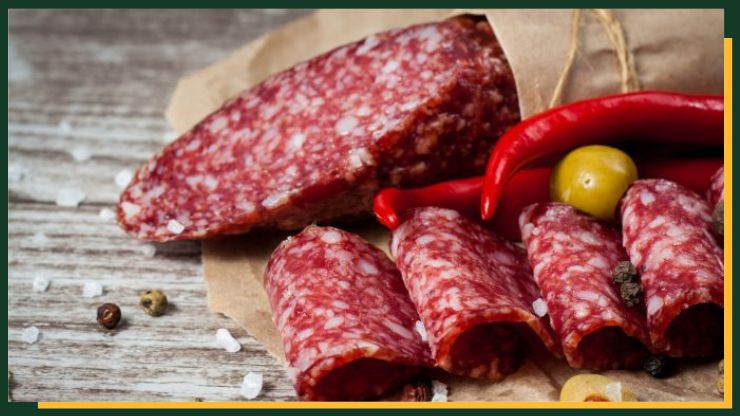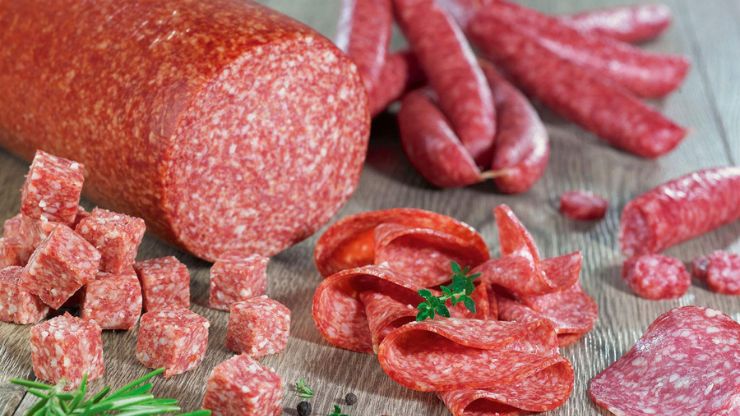Welcome to The Art of Making Fermented Sausages, where time-honored traditions and modern culinary artistry intersect. This craft, rooted in history and diverse cultural practices, transforms simple ingredients into culinary masterpieces through the alchemy of fermentation.
In this guide, we embark on a journey that demystifies the art of making fermented sausages. From the essential basics of fermentation science to the careful selection of ingredients, equipment, and the intricacies of the fermentation process, we delve into the nuances that define this age-old culinary practice.
Whether you’re a seasoned enthusiast or a curious beginner, this exploration promises to unlock the secrets behind creating delectable, tangy, and savory sausages that stand as a testament to the union of tradition and innovation. Come experience with us the delight and fulfillment that come from learning the art of cooking fermented sausages.
Table of Contents
ToggleBasics of Fermentation
Fermentation lies at the heart of crafting exceptional fermented sausages, transforming raw ingredients into delectable delights. This process, driven by the activity of lactic acid bacteria, imparts unique flavors, textures, and preservation qualities to the sausages. Understanding the basics of fermentation is key to mastering this culinary art.
First, fermentation is the process by which microorganisms transform sugars into acids or alcohol; lactic acid bacteria play a key role in this process when it comes to making sausages. These bacteria thrive in an anaerobic environment, contributing not only to the tangy taste but also acting as a natural preservative.
The conditions for successful fermentation involve maintaining an optimal temperature and humidity range. Typically, temperatures around 65-75°F (18-24°C) encourage lactic acid bacteria activity. The humidity level must be sufficient to prevent the sausages from drying out too quickly.
Fermentation time varies but generally lasts for several days. Regular monitoring of pH levels is crucial, ensuring a controlled and safe process. This stage sets the foundation for the distinctive characteristics that make fermented sausages a culinary art form.
Also, Read – Fermented Strawberry Preserves
Ingredients
- Meat:
- Choose high-quality meats, preferably pork. A good ratio is around 80-85% lean meat and 15-20% fat.
- Curing Agents:
- Use curing salts (nitrite/nitrate mix) to prevent the growth of harmful bacteria and enhance the color and flavor of the sausages.
- Starters/Cultures:
- Introduce starter cultures like Lactobacillus bacteria to initiate the fermentation process. This helps lower the pH, inhibiting the growth of undesirable bacteria.
- Seasonings:
- Depending on taste, you can add more spices like garlic, salt, and pepper.
- Casings:
- Natural casings like hog casings are traditional, but artificial casings are also commonly used.
Equipment
- Sausage Stuffer:
- to pack the meat mixture into the casings.
- Fermentation Chamber:
- Maintain a controlled environment for the fermentation process. Temperature and humidity control are crucial.
- Sausage Pricker:
- Used to prick air bubbles out of the sausages during fermentation.
- pH Meter:
- Monitor the pH level during fermentation. It should drop to a level where harmful bacteria cannot thrive.
Also, Read – Ways to Serve Fermented Cranberries
The Art of Making Fermented Sausages

Meat Preparation
For fermented sausages, start with high-quality pork, preferably 80-85% lean meat and 15-20% fat. Grind the meat more easily by cutting it into small pieces. Use a coarse plate to grind, ensuring a textured consistency.
Thoroughly mix in curing agents, starter cultures, and seasonings for an even distribution. This initial meat preparation sets the foundation for the unique flavor and texture of the fermented sausages.
Grinding
Grinding is a crucial step in making fermented sausages. After preparing high-quality pork, use a coarse grinding plate for texture. Ensure the meat is well-chilled to maintain firmness and prevent excessive heat. The coarse grind gives the sausages a unique bite and for improved seasoning and curing chemical absorption.
This process enhances the overall mouthfeel and texture of the final product. For the ingredients to be distributed evenly and to give the fermented sausages their well-balanced flavors and features, consistent grinding is necessary.
Mixing
Mixing is a critical phase in crafting fermented sausages. After grinding the meat, thoroughly combine it with curing agents, starter cultures, and seasonings. Achieving a homogeneous mixture is vital for even distribution of flavors and the proper initiation of the fermentation process.
Don't just scroll, subscribe!
BuzzTrail's unique web-stories are the cure for boredom you've been waiting for.
Ensure that the ingredients are incorporated uniformly to promote consistent texture and taste throughout the sausages. This careful mixing process improves the overall quality and appeal of fermented sausages by adding to their unique and well-balanced taste.
Stuffing
Stuffing is a key step in the creation of fermented sausages. After thoroughly mixing the meat and seasonings, use a sausage stuffer to fill casings. Choose natural or artificial casings according to preference. The stuffing process should be meticulous, ensuring the elimination of air pockets and creating uniform sausages.
Properly filled casings contribute to the final product’s texture and appearance. Take care to avoid overstuffing, as it may lead to burst casings during fermentation. The character of the fermented sausages is eventually shaped by the regulated fermentation and drying processes that follow, which are put in motion by this phase.
Fermentation
An essential step in making fermented sausages is fermentation. After stuffing, place sausages in a controlled environment with temperatures between 65-75°F (18-24°C) and high humidity. Beneficial bacteria initiate fermentation, lowering the pH and enhancing flavors. This process can take several days, during which the sausages develop their distinctive taste.
It’s crucial to monitor pH levels and maintain consistent conditions. Pricking air bubbles out with a sausage pricker aids in uniform fermentation. This transformative phase lays the foundation for the subsequent drying and maturation steps, culminating in the unique and delicious characteristics of fermented sausages.
Drying
Drying is a crucial step in perfecting fermented sausages. After fermentation, gradually reduce the humidity and lower the temperature for controlled drying. This phase, which can span weeks to months, further concentrates flavors and transforms the sausages into a stable, long-lasting product.
Ensure proper ventilation to prevent surface mold while allowing the interior to desiccate. The sausages develop a distinctive firmness and dry outer layer during this patient process. Consistent environmental conditions and careful monitoring guarantee the sausages achieve the desired texture, creating a balanced and shelf-stable final product with rich, complex flavors.
Maturation
Maturation is the final phase in crafting exceptional fermented sausages. After drying, allow the sausages to mature in a cool, dark place. This period, ranging from weeks to months, refines flavors, enhances texture, and harmonizes the overall profile. The sausages undergo subtle changes as enzymes continue to break down proteins and fats.
Throughout the aging process, patience is essential as the flavors mellow and deepen, producing a complex and well-balanced final product. Regularly check for any changes in aroma, texture, or appearance. Properly matured fermented sausages exhibit a complex flavor profile and a satisfying, firm texture, making them ready for consumption or storage.
Storage
After maturation, store fermented sausages in optimal conditions for prolonged enjoyment. Refrigeration or vacuum-sealing helps maintain freshness. For longer shelf life, keep them in a cool, dark place, away from direct sunlight and temperature fluctuations. Slightly increased humidity is beneficial for natural casings in order to avoid over-drying.
Regularly inspect stored sausages for any signs of spoilage or off-odors. Properly stored fermented sausages can last for an extended period, allowing you to savor the fruits of your labor over time. Enjoy these delectable treats sliced, as a snack, or as a flavorful addition to various culinary creations.
Conclusion
In concluding our exploration of the art of making fermented sausages, we celebrate the fusion of tradition and innovation that defines this culinary craft. From the meticulous balance of flavors to the science of fermentation, each step contributes to the creation of a gastronomic masterpiece.
As you embark on your own sausage-making journey, may the joy of experimentation and the satisfaction of preserving age-old techniques inspire you.
Embrace the richness of flavor, the artistry of presentation, and the pleasure of sharing this ancient tradition with fellow enthusiasts. Cheers to the everlasting appeal of fermented sausages – a taste experience that is truly delightful.
FAQs
How do I choose the right starter culture for my fermented sausages?
How do I choose the right starter culture for my fermented sausages?
Selecting the right starter culture depends on your desired flavor profile and the type of sausage you’re making. Consult with suppliers or experienced makers for recommendations based on your preferences.
Can I use synthetic casings instead of natural ones?
Can I use synthetic casings instead of natural ones?
Yes, synthetic casings are a suitable alternative to natural casings. The choice depends on personal preference and the desired characteristics of the final product.
What safety measures should I follow during the sausage-making process?
What safety measures should I follow during the sausage-making process?
Maintain a clean working environment, practice good personal hygiene, and adhere to food safety guidelines. Ensure proper temperature control and avoid contamination to ensure the safety of the final product.

